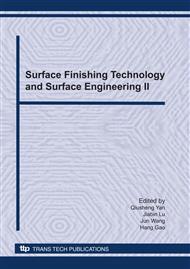p.24
p.30
p.36
p.41
p.46
p.52
p.58
p.64
p.69
Research on the Constraint Mechanism of Abrasive Particle of MR Effect-Based Tiny-Grinding Wheel
Abstract:
To improve the effect of magnetorheological finishing (MRF), it is necessary to control the behavior of abrasive particle effectively in machining process. This article described the machining principle of semi-bond abrasives under the MR effect, then, analyzed the magnetic field of the polishing tool. Based on the magnetic field theory, the constrained model of abrasive particle was established, consequently, the force and the machining behavior of abrasive particle were analyzed. And an experiment was carried out to analyze the effect of the abrasive behavior on the material removal. The results show that the experimental results are identical with the theoretical analysis. Therefore, the control of the particle behavior in process is proved to be available.
Info:
Periodical:
Pages:
46-51
Citation:
Online since:
October 2010
Authors:
Price:
Сopyright:
© 2010 Trans Tech Publications Ltd. All Rights Reserved
Share:
Citation:


